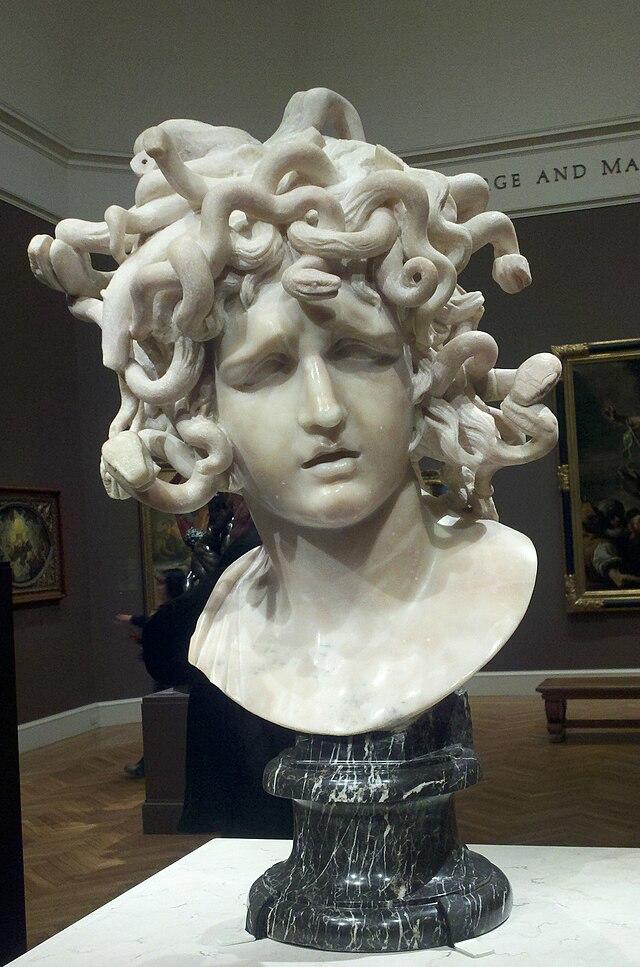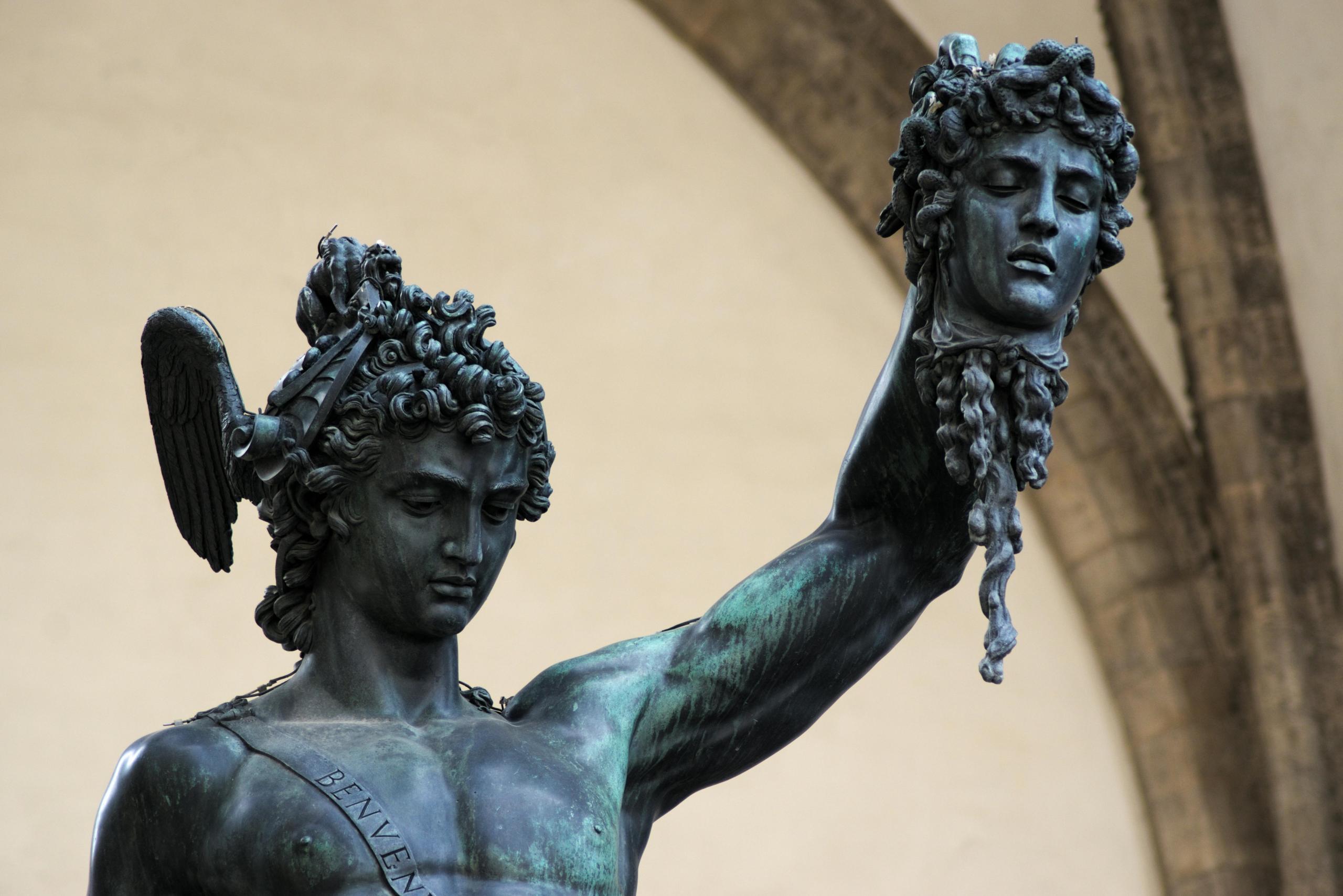This Scottish poet is fond of using techniques that invite the reader into the writer's internal monologue. Few poems do so as effectively as Medusa, whose reputation has earned it a place on the GCSE curriculum year in and year out.
In this article, we will discuss the poem from all angles to understand what makes it such an effective piece of literature, so that you are well-prepared to answer just about any question that might feature on the poem in your GCSE English exam. For additional support, consider connecting with an English tutor near me.
| 💡Element | 💭Theme | 🔎Evidence | ✍Author's intent |
|---|---|---|---|
| Form | 8 stanzas 1 of 5 lines, 6 of 6 lines, 1 of 1 line. | "Look at me now!" | To create a destabilising narrative monologue. |
| Structure | Free verse 8 roughly equal stanzas lacking meter | Stanza 3 starts with a 2-word verse, ends with a verse of 9 words. | Helps the author communicate disjointed thoughts. Shows Medusa's scattered thoughts, later becoming more even. |
| Language | Sibilance Tricolons Metaphors Rhetorical questions | soured-sank; stay-stone Perfect man, Greek god, my own A monster as a jealous woman Wasn't I beautiful? | All used to portray emotional turmoil and transformation. |
| Context | Presenting the Medusa myth from Medusa's perspective. | The poem is a narrative monologue. | To explore feminine dignity, doubtfulness, insecurity and jealousy. |
| Tone | Anger Sadness Pain | "Are you terrified?" "But I know you'll go" "Wasn't I beautiful?" | Presenting the bitterness and disillusionment of betrayal. |

Medusa Poem by Carol Ann Duffy
Medusa's author, Carol Ann Duffy, is a Scottish poet with a trademarked tone. It is instantly identifiable, allowing her to engage her readers effectively.
Her childhood and education were conventional, marked by her love of reading and writing precocity. Like the Romantic poet Percy Shelley, teachers caught on quickly to Ms Duffy's genius. She became a published author at 15 years old. Her writing is easy to understand as it uses language that people connect with and relate to.
... only because, since its inception in the 17th century, no woman had previously held the post.
Carol Ann Duffy
In 1999, Ms Duffy published The World's Wife, the anthology containing Medusa. By that time, she'd been writing professionally for 25 years. As the book published, she was in the running for Poet Laureate, claiming the role 10 years later. She quipped the above while explaining her choice to accept the position.
What to Know About Carol Ann Duffy
As we explore Medusa Carol Ann Duffy, you'll find aspects of this author's personal experiences reflected in the Gorgon's words.
Medusa Poem
You likely know Medusa as a figure of Greek mythology who is depicted as having snakes for hair. She was supposedly capable of turning anyone who looks at her to stone. There are some earlier myths that paint Medusa as a beautiful young woman. In Ovids’ rendition of the story, the snakes were a punishment cursed upon her.
Obviously, there's much more to Medusa's story. A beastly hag with snakes for hair is able to seduce the god of the sea? So much of this tale contradicts older writings (and defies logic!) that it must compel an alternate take.

Duffy’s poem challenges mainstream viewpoints. She introduces new angles to these familiar narratives and characters by presenting them from the female perspective. A thoughtful reading of this work must involve shedding any preconceptions and foreknowledge of Medusa's legend.
... he was great. It was all poetry, very heady, and he was never faithful.
Carol Ann Duffy
Earlier, you noted Ms Duffy's faithless first relationship which, per the quote above, she wasn't shy about discussing. This poem - Medusa, and the collection it appears in (The World's Wife) address the faithless theme. These are the voices of wives, partners and female characters linked to protagonists. Ms Duffy revisits the stories, this time empowering the female figures.

Medusa Poem Analysis: Structure and Form

Your GCSE English exam tasks you to discuss the poem's structure and form. Medusa breaks from standard poetry rules you learnt over the course of the English curriculum.
Duffy expresses Medusa’s emotions and thoughts without the benefit of strict rhyme or meter patterns. She uses the free verse structure effectively, with phrases such as "Look at me" to disrupt the poetic flow, immersing the reader in Medusa’s musings.
For your exam, you’re expected to provide a critical analysis of your studied piece. Thus, you must back up the points you make in your essay with supporting quotes to strengthen your argument. If you need further guidance on structuring your argument, an English tutor near me can help.
🙅♀️ Breaks Rules
- free-verse structure
- lacking meter
- no formal rhyme scheme
🗣️ Form
- eight stanzas
- first stanza: 5 lines
- rest of the stanzas: 6 lines
- final stanza: 1 line
✋ Flow Disruption
- mixing short and long verses
- changing focus
- dramatic monologue
Stanza Breakdown
Within the first five lines, Duffy casts a light on Medusa’s feelings of envy and her subsequent metamorphosis. The focus is scattered and the assertions are disjointed, creating the impression that the emotional injury is new.
As the reader progresses through the poem, the stanzas gradually become more consistent in structure, suggesting Medusa’s increasing adjustment to her new self.
The last two stanzas are arguably the most evocative. They challenge the reader to face Medusa head-on and understand the change she has undergone.
And here you come
with a shield for a heart
and a sword for a tongue
and your girls, your girls.
Wasn’t I beautiful
Wasn’t I fragrant and young?
Look at me now.
What emotional insecurity drives Medusa narrative - was it really an unfaithful partner? Is such a rage capable of incinerating cats, pigs and bees with just a glance - or are those verses effectively used poetic device? We'll never know, of course. Like Robert Minhinnick's Yellow Palm, these deceptively simple verses disguise a universe of pain.
Language
Perfect man, Greek god, my own
The poem itself doesn't have a rhyming scheme but is packed full of rhyme. We find half rhymes, internal rhymes and, in stanzas 3, 4, 5 and 6 some end rhymes. This rhyme helps to unify the lines and create a sense of rhythm. The end rhyme produces a sense of finality, suggesting the transformation is complete.
Sibilance is used in the first two stanzas to create the sound of a hissing snake. Tricolons (groups of three) help develop the rhythm in the poem. Applying the rule of three also emphasises the power of emotions that Medusa is overcome with. Ultimately, this is what turns the lady into a gorgon.
Throughout the poem, Duffy uses different language devices to mark the progression of Medusa's emotional storm.
Rhetorical questions are used to involve but also to intimidate the reader. The last two rhetorical questions in the poem: ‘Wasn’t I beautiful? Wasn’t I fragrant and young?’ elicits the reader's pity and sympathy.
Like the narrator in Thomas Hardy's Neutral Tones, bitterness mingles with disillusionment to create an abject, pitiable creature.
Those questions could just as readily be addressed to the reader.
She longs to be comforted; those queries express the horror she feels by this change in herself.
They may even reflect self-doubt, as though she can no longer believe she once was beautiful.

‘bullet tears’ emphasises the danger that Medusa brings, as well as the harm she does to herself.
Bullets, instruments of violence and pain, clash with tears - a pain-release mechanism. This word pair evokes sympathy from the reader because of her suffering. However, we wonder whether those are tears of rage and, if so, what the rage will result in. The next verse - the rhetorical question: 'Are you terrified?' proves that the second analysis is true.

Medusa Analysis - Carol Ann Duffy Themes
Medusa offers underlying themes that make the poem such a captivating read. Jealousy and betrayal dominate, but struggle underpins them. Carol Ann Duffy tells Medusa's story so that we find sympathy for this supposedly monstrous character. Sympathy that might be hard to muster for Charlotte Mew's farmer.
🔪 Betrayal
- I know you'll go, you'll betray me, stray from home.
- a shield for a heart and a sword for a tongue
😖 Jealousy
- A suspicion, a doubt, a jealousy...
- And your girls, your girls.
🥲 Struggle
- A woman torn with jealousy and self-loathing
- Love for a partner versus fear of betrayal
Far from revelling in her power to destroy at a glance, Medusa looks at what she's become. She sees no cause for glee, no sense of power in destroying the bee, the bird, the cat or the pig.
The poem opens with a depiction of suspicion and uncertainty brewing within Medusa's thoughts. This emotion's ugliness turns her hair into serpents, symbolising how jealousy alters one's being.
Does Medusa wish for a return to her former gentle self? As you progress through the poem, the theme of struggle surfaces. The hissing and spitting sensations illustrate how Medusa’s emotions have materialised physically, presumably changing her forever. It seems the final stanza acknowledges that permanence.
And, finally, betrayal. William Congreve wrote, 'Hell hath no fury like a woman scorned'. Carol Ann Duffy's Medusa is scorned but powerless. Her fury remains in her mind, acts of terrible violence only imagined. She turns the violence inward by torturing herself with visions of the filthy beast she surely must be.
Note that the betrayal is never proven. The first verse tells us as much: Medusa has a suspicion, a jealousy, a doubt - nothing concrete is given.
The alleged betrayal provokes the struggle. It causes her fury and sorrow, an “outpouring of poison." These themes are manifested in the physical form, the turmoil being symbolized in the snakes coming from her head, mirroring her internal jealousy and suffering.
Carol Ann Duffy - Medusa Final Thoughts

You may find Medusa a distressing read. It is an exposé of a jealous woman who is grieving the supposed loss of her partner. The poem is, in fact, a testament to the evocative language.
Duffy uses language in such a way that allows you to witness a lady who has become a monster through her possibly unfounded jealousy.
Remember that the author's personal experiences may have influenced this work. Though apparently unconcerned about her former partner's infidelities, the memory of them is strong enough to provoke the comment above, which she issued years later.
This author makes no secret of her feminist leanings.
Her views on this matter likely helped her paint Medusa in more charitable tones.
This poem, like another in the GCSE anthology titled Bayonet Charge, delivers a stop-motion series of explosive events. Each new visual demands its share of attention.
Have you read of some of the other poems in the collection? Need an extra hand understanding poetry? Why not book a GCSE English tutor to come to your home from the Superprof website? Additionally, if you're looking for personalised support, consider seeking help from an English tutor near me.
















As a Student, I enjoyed reading this article. It helped me expand my knowlage of the poem that i’m studying.
glad it helped! ❤️
As a Student, I enjoyed reading this article. It helped me expand my knowlage of the poem that i’m studying.